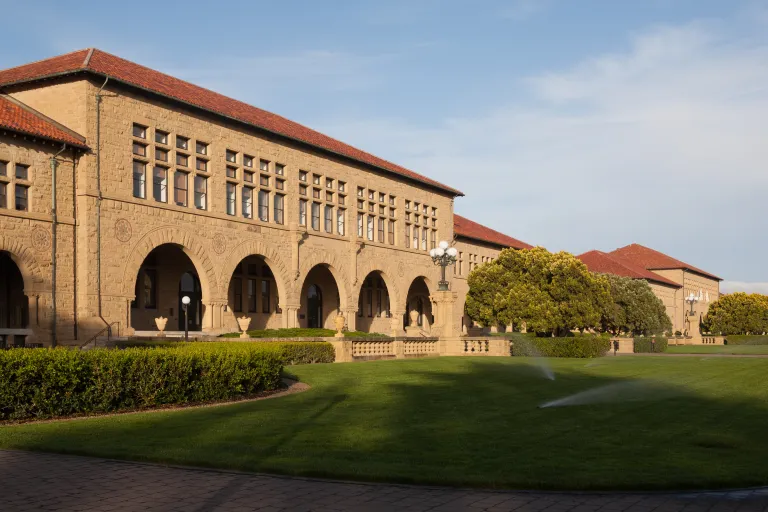This article is the third and final installment in a series examining unique concentrations at Stanford. The first article in the series highlights the Symbolic Systems program, while the second looks at the Global Studies and Human Rights minors.
Stanford’s digital humanities minor aims to integrate research into academics by offering undergraduates the opportunity to apply computational and digital tools to their pursuits in the humanities. Part of the program’s inspiration came from undergraduate work at the Center for Spatial and Textual Analysis (CESTA), Stanford’s international digital humanities center on the top floor of Wallenberg Hall.
“Digital humanities is an exciting, new, avant-garde field of research — but it’s also really dynamically interdisciplinary in terms of its pedagogy,” program director Alice Staveley said.
Origins of the minor
The digital humanities minor was introduced to Stanford in fall 2015.
According to minor co-creator and English professor Elaine Treharne, the minor intends to recognize the growing importance of digital humanities in modern times by codifying existing courses in the digital humanities into a structured academic program at Stanford.
CESTA researchers have implemented tools such as 3D mapping, data visualization techniques and algorithmic literary analysis in projects including the Spatial History Project directed by history professor and CESTA founding director Zephyr Frank, as well as the Stanford Literary Lab directed by assistant professor of Digital Humanities and Literary Lab director Mark Algee-Hewitt.
When CESTA was created in 2012, there was a community of scholars using digital tools to pursue humanities research but no central undergraduate program for the digital humanities, said Treharne, who directs the center.
“We had a lot of undergraduates who would come up to work at CESTA, both as research interns but also as independent researchers, who would take a course in digital humanities,” she added. “They would take those courses and it would contribute to their normal major, but there was no program through which those courses could be made to cohere with a kind of end result.”
Frank, Algee-Hewitt and Treharne all collaborated to design the minor, aiming to “best make digital humanities provisions coherent and come together into something fruitful for undergraduates,” Treharne said.
Digital humanities at Stanford
Students must satisfy a minimum of 20 units for the minor, including a core course selected from one of three clusters: geospatial humanities, quantitative textual analysis or text technologies. In addition, students must take five additional elective courses from a diverse set of academic departments. Elective courses may range from MUSIC 154A: “Sound Art I” to EARTHSYS 44: “Fundamentals of Geographic Information Science.”
Staveley worked with Division of Literatures, Cultures and Languages (DLCL) academic technology specialist Quinn Dombrowski to identify courses relevant to the digital humanities minor. The courses are organized into categories such as computational analysis, media studies and history of technology to help students visualize the many options available across various departments.
Staveley said accessible mentoring is important to helping students navigate and design their intellectual pursuits. She envisions an “intensive advising structure to build up a culture of discussion around and excitement about the program.”
Digital humanities minor Jenny Kim ’19, who is majoring in Science, Technology and Society (STS), said the digital humanities advising team members “are all really nice people, and very passionate.”
“It feels very comfortable talking to them about what I’m interested in,” Kim said. “They’re very genuine in getting to know what you want to do, and what you want to get out of the minor.”
Staveley noted that digital humanities consists of more than just the intersections between technology and English, even though Stanford’s minor is administered by the English department. Since its launch, the digital humanities minor has undergone efforts aimed at increasing its connections with different campus departments. Staveley, who is also a lecturer in the English department, redesigned the digital humanities minor website in December to make it more accessible to students.
“We’ve taken away the requirement that students submit a list of courses when they sign up [for the minor], so we’ve in some sense lowered the threshold for access,” Staveley said.
Staveley also seeks to grow the digital humanities minor by increasing University awareness of the program. She hopes to connect the minor with other schools and departments at Stanford, emphasizing the interdisciplinary potential of digital humanities.
To this end, Treharne said there is a universal importance and merit of any student studying digital humanities, regardless of their primary academic interests.
“Humanists need to be involved in all of the teams on campus that are working with whatever kinds of advanced data science or artificial intelligence.” Treharne said. “Whatever it is, [digital humanities students] have something to contribute.”
This article has been corrected to reflect the correct title of Mark Algee-Hewitt. The Daily regrets this error.
Contact Michelle Leung at mleung2 ‘at’ stanford.edu.
